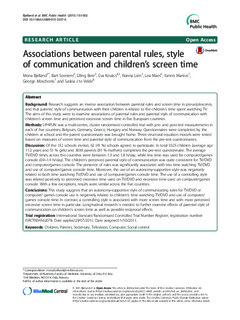| dc.contributor.author | Bjelland, Mona | |
| dc.contributor.author | Soenens, Bart | |
| dc.contributor.author | Bere, Elling | |
| dc.contributor.author | Kovács, Éva | |
| dc.contributor.author | Lien, Nanna | |
| dc.contributor.author | Maes, Lea | |
| dc.contributor.author | Manios, Yannis | |
| dc.contributor.author | Moschonis, George | |
| dc.contributor.author | te Velde, Saskia J. | |
| dc.date.accessioned | 2015-11-03T13:57:06Z | |
| dc.date.available | 2015-11-03T13:57:06Z | |
| dc.date.issued | 2015 | |
| dc.identifier.citation | Bjelland, M., Soenens, B., Bere, E., Kovacs, E., Lien, N., Maes, L., . . . te Velde, S. J. (2015). Associations between parental rules, style of communication and children's screen time. BMC Public Health, 15. doi:10.1186/s12889-015-2337-6 | nb_NO |
| dc.identifier.issn | 1471-2458 | |
| dc.identifier.uri | http://hdl.handle.net/11250/2359140 | |
| dc.description | Published version of an article from the journal BMC Public Health http://dx.doi.org/10.1186/s12889-015-2337-6. Also available from BMC | nb_NO |
| dc.description.abstract | Background: Research suggests an inverse association between parental rules and screen time in pre-adolescents, and that parents' style of communication with their children is related to the children's time spent watching TV. The aims of this study were to examine associations of parental rules and parental style of communication with children's screen time and perceived excessive screen time in five European countries. Methods: UP4FUN was a multi-centre, cluster randomised controlled trial with pre- and post-test measurements in each of five countries; Belgium, Germany, Greece, Hungary and Norway. Questionnaires were completed by the children at school and the parent questionnaire was brought home. Three structural equation models were tested based on measures of screen time and parental style of communication from the pre- test questionnaires. Discussion: Of the 152 schools invited, 62 (41 %) schools agreed to participate. In total 3325 children (average age 11.2 years and 51 % girls) and 3038 parents (81 % mothers) completed the pre- test questionnaire. The average TV/DVD times across the countries were between 1.5 and 1.8 h/day, while less time was used for computer/games console (0.9-1.4 h/day). The children's perceived parental style of communication was quite consistent for TV/DVD and computer/games console. The presence of rules was significantly associated with less time watching TV/DVD and use of computer/games console time. Moreover, the use of an autonomy-supportive style was negatively related to both time watching TV/DVD and use of computer/games console time. The use of a controlling style was related positively to perceived excessive time used on TV/DVD and excessive time used on computer/ games console. With a few exceptions, results were similar across the five countries. Conclusions: This study suggests that an autonomy-supportive style of communicating rules for TV/DVD or computer/games console use is negatively related to children's time watching TV/DVD and use of computer/games console time. In contrast, a controlling style is associated with more screen time and with more perceived excessive screen time in particular. Longitudinal research is needed to further examine effects of parental style of communication on children's screen time as well as possible reciprocal effects. | nb_NO |
| dc.language.iso | eng | nb_NO |
| dc.publisher | Biomed Central | nb_NO |
| dc.rights | Navngivelse 3.0 Norge | * |
| dc.rights.uri | http://creativecommons.org/licenses/by/3.0/no/ | * |
| dc.title | Associations between parental rules, style of communication and children's screen time | nb_NO |
| dc.type | Journal article | nb_NO |
| dc.type | Peer reviewed | nb_NO |
| dc.subject.nsi | VDP::Medical disciplines: 700::Health sciences: 800::Community medicine, Social medicine: 801 | nb_NO |
| dc.source.pagenumber | 13 p. | nb_NO |
| dc.source.volume | 15 | nb_NO |
| dc.source.journal | Bmc Public Health | nb_NO |
| dc.identifier.doi | 10.1186/s12889-015-2337-6 | |

